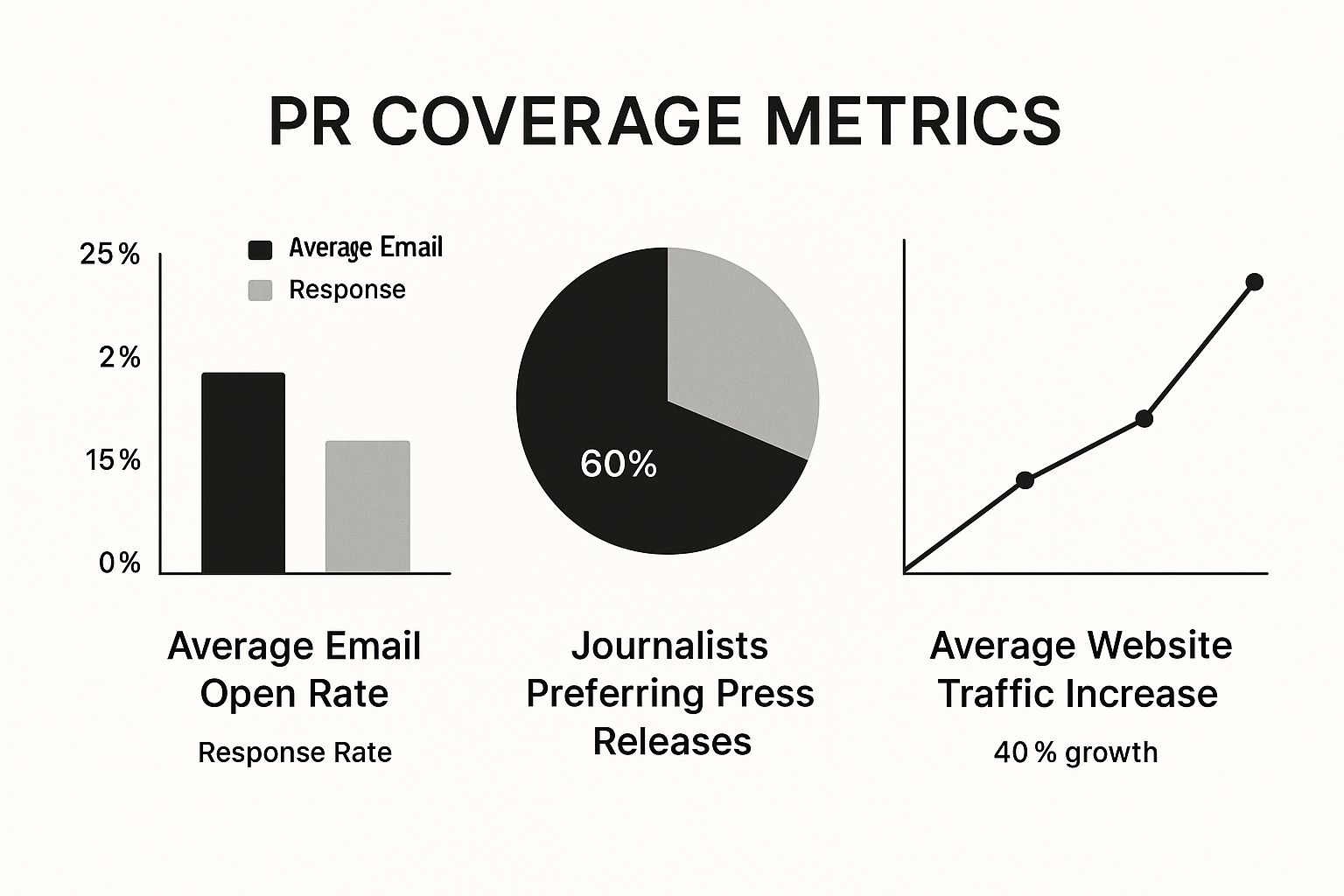
How to Get PR Coverage: Real Strategies From Media Insiders
Why Your Current PR Approach Isn't Working
Let's be honest, getting press coverage these days can feel like a real uphill battle. You pour your heart into crafting the perfect press release, meticulously build media lists, and send pitch after pitch… only to be met with deafening silence. It's incredibly frustrating, and I've been there. The truth is, most PR strategies fall flat because they're clinging to outdated tactics. The media landscape has evolved, and if you're not evolving with it, you're getting left behind.
The days of mass- emailing generic press releases are over. Journalists are drowning in pitches, but paradoxically, they're also desperate for genuinely captivating stories. Their inboxes are overflowing, and algorithm updates have completely reshaped what editors are looking for. They want engaging narratives that resonate with their audience, not just another run-of-the-mill company announcement.
This shift demands a new perspective. Instead of focusing on how to get coverage, you need to focus on how to earn it. This means truly understanding what journalists need and how you can help them craft compelling stories. For example, instead of sending a generic press release about your latest product, think about offering an exclusive interview with your CEO about the industry trends that inspired its creation. This gives journalists valuable, original content—something much more appealing than a recycled press release.

The infographic above illustrates some key PR metrics, including email open and response rates, journalist press release preferences, and website traffic increases after securing coverage. Notice how even getting your email opened is a hurdle, with an average open rate of just 25% and a response rate of only 15%. While 60% of journalists still prefer press releases, the low engagement rates suggest they’re often not even being read. However, the 40% boost in website traffic after successful coverage underscores the huge payoff for those who crack the code. Furthermore, the UK public relations services market is projected to hit USD 6.26 billion by 2025, expanding at a CAGR of 6.67%. This growth signifies a greater need for effective PR strategies, especially those focused on media coverage. With almost 90.17% of the UK population online, a robust digital presence is non-negotiable for PR success. You can find more insights about the UK PR market here: https://www.mordorintelligence.com/industry-reports/united-kingdom-public-relation-services-industry-market.
So, how do you get your pitches noticed and finally master the art of securing effective PR coverage? Let's dive into that.
Rethinking Your PR Strategy
To understand where we're going, let's look at where we've been. The following table contrasts traditional PR tactics with the more modern, results-driven approaches you need to adopt.
Traditional vs Modern PR Approaches
| Traditional PR | Modern PR | Success Rate | Time Investment |
|---|---|---|---|
| Sending generic press releases to large media lists | Targeted pitches personalized for individual journalists | Low | High (initially, but less over time with established relationships) |
| Focusing on quantity over quality of coverage | Prioritizing placements in relevant, high-authority publications | Low | High |
| One-way communication (pushing information out) | Two-way engagement (building relationships with journalists) | Low | High |
| Measuring success based on vanity metrics (e.g., number of press releases sent) | Tracking meaningful metrics (e.g., website traffic, lead generation) | Low | High |
As you can see, modern PR is about building genuine relationships and providing real value. It takes more effort upfront, but it pays off in the long run with more impactful coverage.
Finding The Right Journalists Who Actually Care

Forget sending generic pitches to huge media lists. Seriously, it's a one-way ticket to the spam folder. If you’re looking for PR that makes a real impact, you need to connect with journalists who genuinely care about your story. It takes a bit of digging, but the payoff is huge.
Think of yourself as a matchmaker. You’re not just looking for any journalist; you’re looking for the perfect match for your story. That means understanding their area of expertise (their beat), their audience, and their writing style. Pitching a fintech story to a food writer? Total non-starter. They won’t bite, and your email might not even see the light of day.
Using Social Media Intelligence
Social media is a goldmine for understanding what journalists are interested in. Follow them on Twitter, LinkedIn, and other platforms they use. See what they’re talking about, what articles they share, and who they interact with. It’s like getting a sneak peek into their brains. You'll quickly learn what they consider newsworthy and how to craft a pitch that grabs their attention.
Analysing Publications
Don't just focus on individual journalists; understand the publications, too. Look at their recent articles, their editorial calendars (if they have one), and who they’re trying to reach. What kind of stories do they usually publish? What’s their tone and style? Knowing this helps you figure out if your story is a good fit. In some places, like the UK, publications have really strong personalities and distinct readerships. You wouldn’t pitch the same story to The Guardian as you would to The Financial Times.
Insider Networking
Building relationships with journalists takes time, but it's the single most effective way to get your story heard. Go to industry events, connect with journalists on LinkedIn, and engage with their content online. Don't just pitch; offer value. Share useful insights, provide helpful resources, and build real connections. This can open doors and make a world of difference, especially in niche areas like FinTech where trust and credibility are paramount.
Before you start reaching out, a good checklist can keep you focused. Use the table below to make sure you're targeting the right journalists and publications.
| Research Element | Why It Matters | Where to Find It | Red Flags |
|---|---|---|---|
| Journalist's Beat | Ensures your pitch is relevant to their area of expertise. | Publication website, Twitter bio, LinkedIn profile, Muck Rack | Covers topics completely unrelated to your story. |
| Recent Coverage | Shows their current interests and writing style. | Publication website, Twitter feed, Muck Rack | Hasn't written about similar topics recently. |
| Target Audience | Ensures your target audience aligns with the publication's readership. | Publication website, media kit | Publication's audience doesn't match your target demographic. |
| Publication's Tone & Style | Helps you tailor your pitch to fit their editorial guidelines. | Publication website, recent articles | A mismatch between your brand voice and the publication's style. |
| Engagement on Social Media | Provides insights into what resonates with their audience. | Twitter, LinkedIn | Low engagement or negative sentiment towards similar topics. |
This checklist helps you gather crucial information about potential media targets. By paying attention to these elements, you can dramatically increase your chances of getting your story covered and avoid wasting time on pitches that will likely be ignored.
Writing Pitches That Cut Through The Noise

Let's be honest, getting a journalist's attention is tough. Their inbox is a battlefield, and your pitch isn't just up against other PR hopefuls—it's fighting for airtime against everything under the sun. So, how do you make yours stand out?
Crafting Killer Subject Lines
Your subject line is everything. It's the first impression, the gatekeeper, the headline that’ll make or break you. Ditch the generic stuff like "Press Release." Think intrigue. Think specific. For example, I once pitched a story about an AI tool for financial advisors. My subject line? "AI is Changing How Brits Manage Their Money: Exclusive Interview Opportunity." See what I did there? Highlighted relevance and offered something unique.
Structuring Your Pitch For Success
Okay, so you’ve got them to open it. Now, hold their attention. Journalists are time-poor. Get to the point. Answer the "Why should I care?" question immediately. Think inverted pyramid – most important info first. Start with a concise summary of your story angle and its relevance to their readers. Then, add supporting details and data. Keep it brief, focused, and skimmable. You might be interested in: Check out our guide on PR release format.
Presenting Your Story: Make Their Job Easier
Journalists are constantly searching for good stories. Make their lives easier by presenting yours clearly and concisely. Don't just talk about what your company does; explain why it matters. Focus on the human element. How does your story connect with current events or wider trends? Offer exclusives – access to data, interviews, or behind-the-scenes glimpses. In the UK, securing PR coverage often means tapping into the latest digital PR trends. In 2025, things are moving fast, thanks to algorithm updates, AI tools, and the ever-changing media landscape. Think data-driven campaigns and integrated PR/SEO strategies. Discover more insights on digital PR trends here.
Learning From Real-World Examples
Want to know the best way to learn how to get PR coverage? Study the winners. Look at pitches that landed coverage in top publications. Deconstruct them. What was the subject line? The structure? The angle? By analyzing successful pitches, you'll pick up invaluable tips you can use in your own outreach. Follow these tips, craft a compelling narrative, and you'll dramatically improve your chances of getting your pitches read, your stories covered, and your brand recognized.
Building Media Relationships That Actually Matter
The best PR doesn't come from a perfect pitch. It comes from the relationships you build before you even need them. Think of it like networking. You wouldn't walk up to someone at a conference and immediately hit them with a favor, right? Journalism is the same. It’s about real connections, becoming a resource they value. I’ve seen how powerful these relationships can be, transforming PR efforts from a struggle to a steady flow of opportunities.
Adding Value Without Being Pushy
How do you build these relationships without seeming like you just want something? By genuinely adding value to their work. Share helpful industry insights, offer fresh perspectives on current events, or even connect them with sources they might find useful.
For example, let’s say a journalist is working on a story about sustainable investments. You know someone at a leading green tech company? Making that introduction can be incredibly valuable. It's not about expecting something back; it’s about being helpful and dependable.
Maintaining Connections During Quiet Periods
Building a relationship isn’t a one-time thing. It takes ongoing effort. Don't just reach out when you need something. Engage with their articles on social media, share their work with your network, and occasionally check in to see what they’re working on. This keeps you on their radar and strengthens the connection. You might be interested in: Learn more in our article about what is a PR campaign.
This regular interaction, even without a specific ask, builds trust and rapport. It’s like watering a plant – consistent care leads to growth.
Leveraging Social Media Interactions
Social media is a great tool for nurturing media relationships. Don’t just follow journalists; interact with their content! Comment on their articles, share their posts, and participate in relevant discussions. This shows genuine interest in their work and creates a sense of community.
It's also a fantastic way to stay up-to-date on what they’re covering and understand their perspectives, allowing you to tailor future pitches and offer more relevant contributions.
From Cold Contacts To Warm Advocates
I’ve seen cold contacts become warm advocates just by consistently offering value and showing real interest. This takes time, but it’s an investment that pays off big. When journalists know and trust you, they’re much more likely to open your emails, read your pitches, and ultimately, offer you coverage.
Building these relationships is the core of a successful, long-term PR strategy. It's not about getting coverage today; it’s about a consistent flow of opportunities down the line. By regularly engaging and offering value, you become a go-to source, making securing PR coverage much more likely. This builds a solid foundation for future coverage opportunities.
Standing Out When Everyone's Fighting For Attention

Getting noticed by the media is a tough gig. Everyone wants that prime spot in a major publication. It feels like a constant battle to get your story heard. But this competitive landscape presents a real opportunity. If you can learn to stand out, you'll truly shine. Thinking strategically about your narrative, timing, and angle is key to getting that valuable PR coverage.
Finding Your Unique Angle
Let's be honest, journalists are bombarded with the same stories day in and day out. Another press release about a new product launch? They've seen it all before. Don't just rehash the obvious; find a fresh perspective. What makes your story different? What's the angle nobody's talking about?
For example, instead of simply announcing a new eco-friendly packaging initiative, think about tying it into the growing trend of eco-conscious consumers in the UK. Frame your story around how this initiative addresses those concerns and reflects the changing values of British shoppers. Suddenly, your story is more relevant and interesting to journalists.
Riding The News Cycle Wave
Timing is everything. Connecting your story to current events or trending topics can significantly boost its visibility. It’s not about chasing every trend, but about smartly aligning your message with conversations that are already happening in the media. For example, during the cost of living crisis, a financial services company could offer expert advice on budgeting. This adds value to the current discussion and positions them as a thought leader.
Crafting Compelling Narratives
At their core, journalists are storytellers. Give them a narrative they can work with. Instead of boring them with facts and figures, focus on the human element. What's the emotional heart of your story? Who are the people involved, and why should we care? A personal story, a relatable struggle, a moment of triumph—these are the things that truly connect with people.
This increased competition in the UK PR world isn't a surprise. Twenty agencies listed in PRWeek's UK Top 150 Consultancies table saw revenue growth of over 20%. This shows a huge demand for PR services, making media coverage even harder to secure. As more brands understand how vital PR is to their marketing, the standard is getting higher. Want to learn more about the UK PR agency landscape?
Learning From The Best in the UK
Look at how successful UK brands like Monzo or BrewDog have grabbed the media's attention. They've built strong narratives, engaged directly with their audiences, and created a sense of community. These tactics work, no matter your budget or connections. Learn from these examples and put these strategies into action. You can cut through the noise and get the attention you deserve. It’s all about being smart, creative, and offering something truly valuable to journalists and their readers.
Turning Coverage Into Real Business Impact
Landing a piece in a major publication like The Guardian or The Telegraph is a huge win, no doubt. But it's really just the starting point. The real payoff comes from turning that press hit into actual business results. It's like hitting a home run in baseball—exciting, sure, but it doesn't mean much unless you bring those runners home and score some runs. So, how do you transform a single mention into a marketing powerhouse?
Amplifying Your Coverage Across Multiple Channels
Don't just let that coverage sit there on the news site. Spread the word! Share it everywhere—your website, social media channels, email newsletters, even internal communications. Think of each mention as a valuable piece of content you can reuse and amplify. For instance, a glowing review in a respected tech publication could become a catchy social media graphic, a quote for your website’s homepage, or even a quick snippet for your email signature. This expands its reach and builds your credibility.
Using Social Proof To Build Credibility
Media coverage is social proof at its finest. It’s like having a trusted friend recommend you to others. Use that to build trust with potential customers. Showcase media logos on your website, sprinkle quotes from articles into your marketing materials, and highlight positive reviews in your sales pitches. This instills confidence and encourages conversions. Picture seeing the BBC logo next to a testimonial on a website—that’s instant credibility.
Measuring The True ROI of PR
Measuring the impact of PR can be tricky. It’s not always as simple as tracking ad clicks. But you can measure it. Look for bumps in website traffic after a piece goes live, keep an eye on social media engagement, and monitor brand mentions. These metrics offer valuable insights into how PR is influencing your brand awareness and reach. Even qualitative feedback, like an uptick in positive customer comments, can be incredibly useful.
From Single Articles To Comprehensive Campaigns
Savvy brands don’t just get coverage; they use it. I've seen companies build entire marketing campaigns around a single article. They create engaging social media posts, run targeted ads featuring the article, and even produce follow-up content based on the themes covered. This magnifies the initial coverage and generates even more buzz. It’s like turning a spark into a bonfire. You might also be interested in: Check out our guide on how to get press coverage.
Leveraging PR For Long-Term Growth
Media coverage can be a launching pad for bigger things. Use it to attract investors, form strategic partnerships, and solidify your status as a thought leader in your industry. A prominent feature in a major financial publication can open doors to conversations with potential investors or create opportunities for collaborations with other key players. It’s about viewing PR not just as a publicity tactic, but as a strategic tool for long-term business growth. Turning media mentions into real business results is vital for maximizing your PR efforts. By amplifying your coverage, leveraging social proof, and measuring your ROI, you can turn those valuable media mentions into tangible business success.
Your Practical Roadmap To Consistent PR Success
So, you've got the PR basics down. Excellent! Now, let's talk about building a system that delivers consistent results. Forget crossing your fingers and hoping for the best—this is about creating a sustainable PR machine.
Building Your PR System
Think of your PR efforts less like throwing spaghetti at the wall and more like a well-oiled engine. It's about repeatable processes, clear goals, and constantly tweaking your approach based on what's actually working.
Here’s a framework to get you started. Think of it as your PR playbook:
-
Target Identification: Knowing your audience is PR 101. Continuously research and update your list of relevant journalists and publications. Don't just dust off that old media list—actively engage with journalists on platforms like Twitter and LinkedIn, and stay on top of industry shifts.
-
Content Planning: Just like your regular content, your PR needs a plan. Create a content calendar specifically for PR. What stories do you want to tell? What angles will resonate with different publications? Think about tying your stories to current events or trending topics. Newsjacking can be incredibly effective.
-
Pitching & Follow-Up: Crafting a compelling pitch is an art. Develop a system for writing pitches that grab attention and following up strategically (without becoming a pest). Templates can be helpful, but always personalize them. Remember, journalists are inundated with pitches. Make it easy for them to see the value in your story.
-
Relationship Nurturing: PR is about building genuine, long-term relationships. Offer value beyond just pitching stories. Share journalists' work, engage in relevant conversations on social media, and position yourself as a resource. It's about becoming part of the conversation, not just shouting from the sidelines.
-
Measurement & Analysis: How do you know what's working? Track your progress. What’s resonating? What's falling flat? What can you do better next time? Don’t get hung up on vanity metrics like the number of articles. Look at website traffic, social media engagement, and lead generation to understand the real impact of your PR. As Grace Hopper, a computer programming pioneer, famously said, "One accurate measurement is worth a thousand expert opinions."
Implementing Your Plan
Start small, but be consistent. Don’t try to do everything at once. Pick one or two key publications and build momentum. Like building a house, you need a solid foundation before adding the roof. Small wins will give you the confidence to expand your efforts.
Scaling For Growth
As your business grows, your PR should too. Develop scalable processes. Think about using PR tools like Cision or Meltwater to manage your media lists, track coverage, and analyze results. These tools can save you time and help you stay organized.
Want to elevate your brand's PR game and secure consistent media coverage? Blackbird Digital, a dynamic marketing agency specialising in innovative digital PR, can help. We've secured placements in top-tier publications like the BBC, Bloomberg, Forbes, and the Daily Mail. Discover how we can help you achieve your PR goals.




